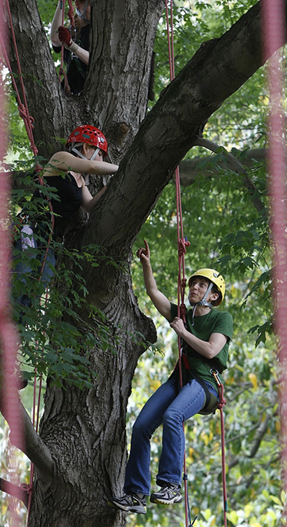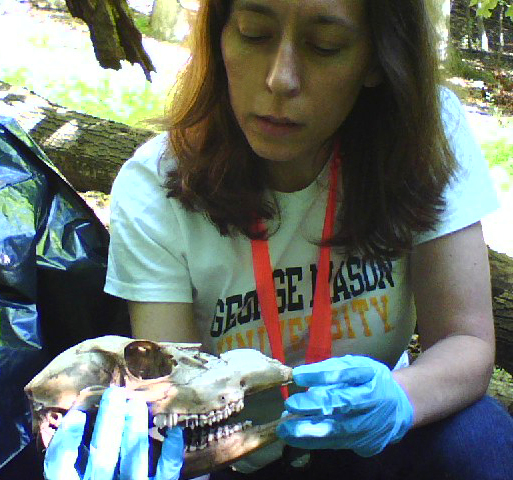Our_Research
Insect and Plant Phenology:
Ecologists generally assume that plant phenology - the timing of plant growth, flowering, leaf loss and other important life-history processes - is principally driven by abiotic factors such as day length and temperature. Data from our research support the hypothesis that insect herbivory generates substantial variation in plant phenology, particularly autumn foliar senescence. Our lab is examining how insects may both advance and delay plant senescence processes, resulting in variability in the vibrancy and duration of autumn leaf colors. This work is part of a larger project to document changes in the diversity and phenology of plant and herbivore communities with climate change.Insects and Nitrogen-fixing Plants
Mutualisms between plants and nitrogen-fixing rhizobia bacteria increase plant nitrogen and promote plant growth, but they also may alter secondary plant biochemical pathways with consequences for herbivores. Conversely, secondary biochemical pathways may dictate a plant’s ability to form mutualism with rhizobia. Our lab is examining how variation in alkaloid defenses in species of wild indigo (Baptisia) is altered by rhizobial nodulation. Legumes like wild indigo also exude flavonoid compounds from their roots to which rhizobia respond by initiating formation of the nodules necessary to support the plant-bacteria symbiosis. As with alkaloids, flavonoid profiles vary among Baptisia species, and identity and concentration of flavonoids in root exudates drive patterns of rhizobia host-specificity and gene expression. In collaboration with Dr. Peter Van Zandt at Birmingham Southern College, our lab is examining patterns of herbivory and flavonoid production to determine if herbivore-damaged plants increase root nodulation and, subsequently, expression of toxic alkaloids.Canopy Insect Communities:
As a result of large differences in plant diversity and morphology and in abiotic regimes, tropical tree canopies have substantially different architecture, phenology, and resource availability than temperate canopies. This suggests that while tropical canopies show vertical stratification and differentiation of insect communities, temperate canopies, on the other hand, should show less stratification - their faunas may be subsets of the understory community. Research in our lab investigates patterns of diversity and stratification in insect communities in both tropical and temperate forests.Forest Sustainability and Insect Diversity:
“Sustainable harvesting” is a buzz word in forestry and commercially marketed timber products. Yet, few studies document if harvest practices are truly sustainable over the lifetime of a forest – more than 100 years! This is the objective of our replicated before/after, control/impact experiment, The Missouri Forest Ecosystem Project (MOFEP). Its long term goal is to compare the sustainability of different types of logging by studying biodiversity, coordinated changes in biogeochemical processes, and forest recovery. As a part of the broader MOFEP experiment, Dr. Robert Marquis at UM-St. Louis is investigating the influence of timber harvest regimes on oak insect herbivores, and members of our lab have collaborated with Dr. Marquis on this research for more than a decade. Our portion of the MOFEP project is unique in several respects. First, we examine the impact of disturbance at the landscape scale: that is, we ask “how do insects within intact portions of disturbed landscapes respond?” Furthermore, we examine the effects of disturbance on larval life-stages rather than charismatic adult Lepidoptera. The impacts of disturbance on larval stages are important because it is in this stage that Lepidoptera cause the most damage to trees and potentially reduce the rate at which forests recover after logging. To date, our results suggest that the negative impacts of both selective logging and clear-cutting on Lepidoptera diversity are temporally delayed, mitigated by previous disturbance and site management history, highly localized in their effects, exacerbated by impacts of disturbance on higher trophic levels, and likely to increase with harvesting cycles less than 100 years.Invertebrate Conservation:
In addition to our main research objectives, our lab has a mandate to promote the conservation of Virginia's native invertebrates. To that end, we have undertaken investigations of a wide range of invertebrates, including mosquitoes (Diptera: Culicidae), dragonflies and damselflies (Odonata), the Zebra Swallowtail (Eurytides marcellus), and, most recently, fireflies (Coleoptera: Lampyridae) and their gastropod and annelid prey. These projects have been funded in part by the Virginia Academy of Science and the Washington Biologists' Field Club. For more information on these projects, contact Dr. Forkner.Forensic Entomology:
The goal of our medico-criminal entomology research is to quantify the range and variability of arrival times at corpses for forensically important Coleoptera, to identify habitat preferences for the dominant necrophagous Coleoptera species encountered, and to determine the degree to which insect and vertebrate corpse scavengers distribute evidence within a location and how this varies over time (i.e., establish degree of surface scatter and spatial extent of a death scene for evidence collection). An additional long term goal of our lab is to establish a database of DNA barcodes for forensically important Virginia insects. This work is accomplished with the assistance and support of the Fairfax Police Department and the GMU Forensics program.




